WWII pigeon project led to modern touch screens
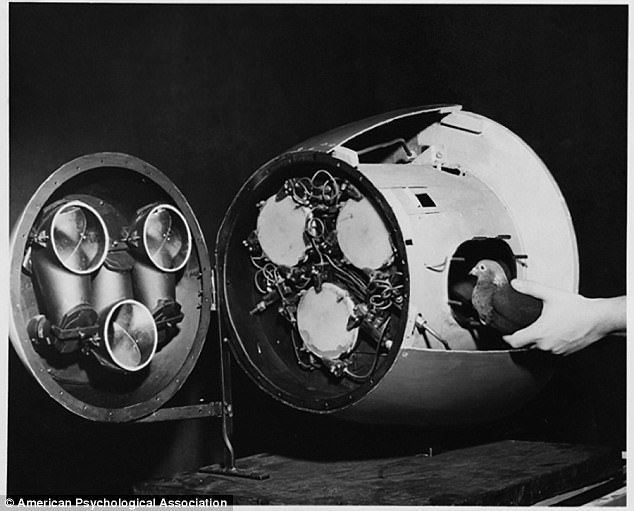
Pigeons trained to drop artillery from the sky paved the way for the modern touch screen.
During World War II, the US Navy and National Institute of Standards and Technology (NIST) trained the birds to peck at screens in the nose of gliders so the military could drop bombs without sending humans into dangerous territory.
The conductive touchscreen display technology the pigeons used is now in phones, tablets, wearables, laptops, and other devices – and has been revealed in a new video.
Scroll down for video
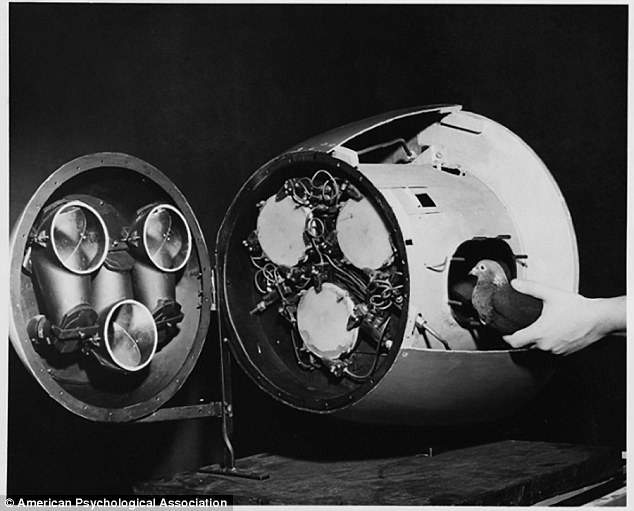
During World War II, the US Navy and National Institute of Standards and Technology (NIST) trained the birds to peck at screens in the nose of gliders so the military could drop bombs without sending humans into dangerous territory
Without satellite and GPS, the bombs available during this era were 'dumb,' meaning once dropped, they could be moved by the wind.
In order to successfully hit targets, pilots had to fly low to the ground – this was dangerous and increased the likelihood of being shot down by enemies.
One option was to fly high and drop several bombs in the hopes that at least one would hit the target, but that was inefficient, expensive and led to more collateral damage.
When NSIT – then called the National Bureau of Standards or NB – developed a glider that could carry a 1,000-pound bomb, it needed a new type of guidance system that could ensure safety and accuracy.
At that point, B.F Skinner, a psychologist known as a father of behaviorism along with Ivan Pavlov, proposed using pigeons.
'I watched a flock of birds lifting and wheeling in formation [in the sky],' he later said about the idea.
'Suddenly, I saw them as 'devices' with excellent vision and extraordinary maneuverability. Could they not guide a missile?'
Behavioral conditioning of animals was Skinner's specialty, and he specifically trained them by withholding rewards.
He first designed a harness that would hold a pigeon's body and wings while allowing its head and neck to move freely.
HOW THE PIGEONS BOMBS WORK
Psychologist B.F Skinner trained pigeons to eat seeds from screens showing video footage of battle zones, puttig their favorite seeds on the most difficult to reach targets.
By gradually increasing the time between the pigeon's peck and its food reward, Skinner trained the birds to peck furiously at the image as it moved.
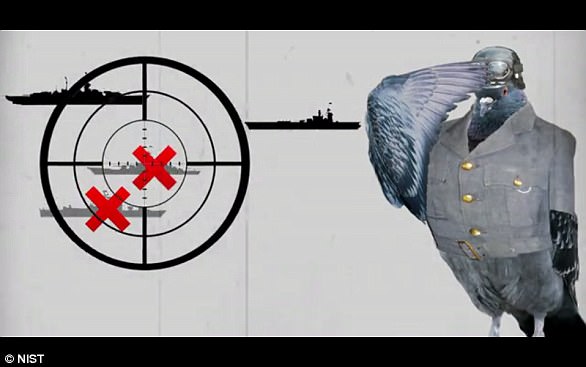
To teach them, Skinner trained pigeons to eat seeds from screens showing video footage of battle zones. He put their favorite seeds on the most difficult to reach targets, such as ships in enemy waters.
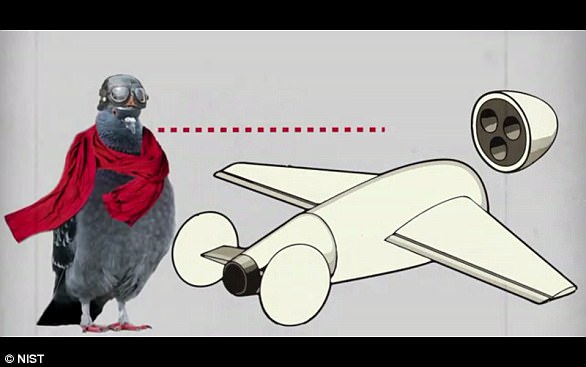
A clear lens in the front of the glider would project an image of the ground below onto the a screen a conductive surface
Eventually, the birds were able to continuously peck 10,000 times in 45 minutes, which was much longer than the time needed for a falling bomb to reach its target.
A clear lens in the front of the glider would project an image of the ground below onto the a screen a conductive surface.
The pigeon would have a gold electrode attached to the end of its beak and peck at the image, which sent electrical signals to the servomechanism controlling the wings.
The pigeon could peck in the center of the screen to keep the bomb on its current course or peck to the left or right to steer it accordingly.
Then to teach them, Skinner trained pigeons to eat seeds from screens showing video footage of battle zones.
He put their favorite seeds on the most difficult to reach targets, such as ships in enemy waters.
Skinner also gave the pigeons 'special reinforcements' in the form of hemp seeds to help them acclimate to the vibrations and noise, which he said they found 'particularly delectable.'
By gradually increasing the time between the pigeon's peck and its food reward, Skinner trained the birds to peck furiously at the image as it moved.
Eventually, the birds were able to continuously peck 10,000 times in 45 minutes, which was much longer than the time needed for a falling bomb to reach its target.
A clear lens in the front of the glider would project an image of the ground below onto the a screen a conductive surface.
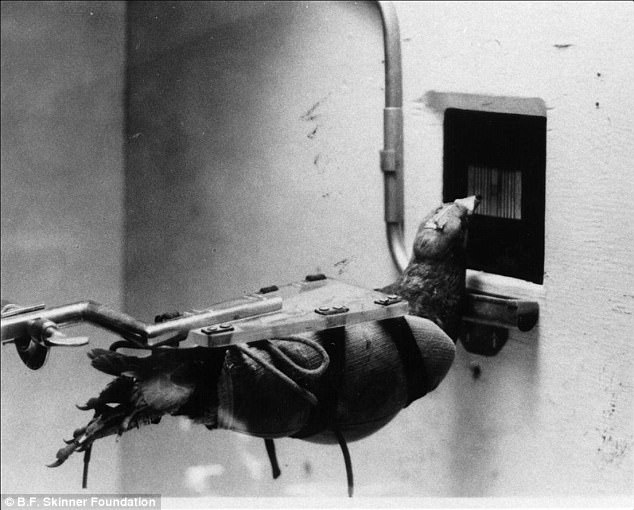
Eventually, the birds were able to continuously peck 10,000 times in 45 minutes, which was much longer than the time needed for a falling bomb to reach its target
The pigeon would have a gold electrode attached to the end of its beck and peck at the image, which sent electrical signals to the servomechanism controlling the wings.
The pigeon could peck in the center of the screen to keep the bomb on its current course or peck to the left or right to steer it accordingly.
While the system worked perfectly in tests, the Navy was hesitant to actually put pigeons in control of its expensive and fatal bombs, so no birds ever attempted an actual military missions.
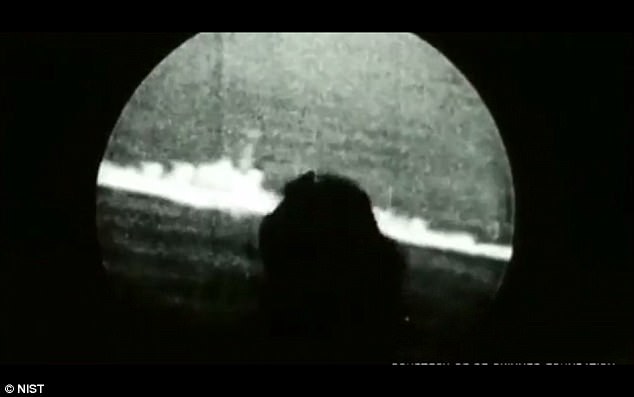
The pigeon could peck in the center of the screen to keep the bomb on its current course or peck to the left or right to steer it accordingly
'Clearly [they] had trouble accepting a psychological approach to an engineering problem,' one historian wrote.
At the time, Skinner said: 'We had begun to realize that a pigeon was more easily controlled than a physical scientist serving on a committee.'
'It was very difficult to convince the latter that the former was an orderly system.'
'We, therefore, multiplied the probability of success by designing a multiple bird unit.'
Skinner tried again by adding set of co-pilots for each pigeon – under the new system, three pigeons would fly the glider and two of them would have to 'agree' on a target by pecking at the same one to steer the bomb.
But still the Navy was not convinced and looked to a bat-inspired radio-based echolocation guidance system developed by Western Electric.
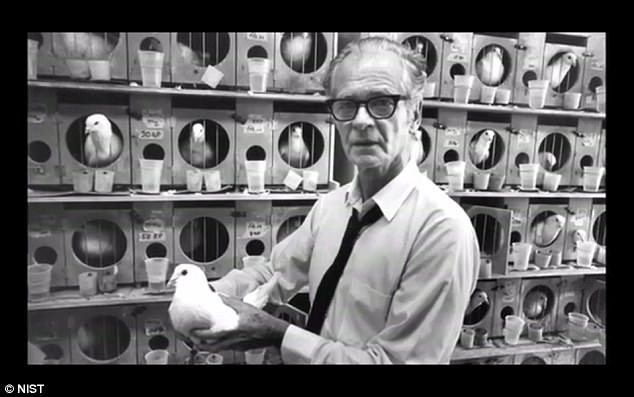
When NSIT developed a glider that could carry a 1,000-pound bomb, it needed a new type of guidance system that could ensure safety and accuracy. At that point, B.F Skinner (pictured) proposed using pigeons
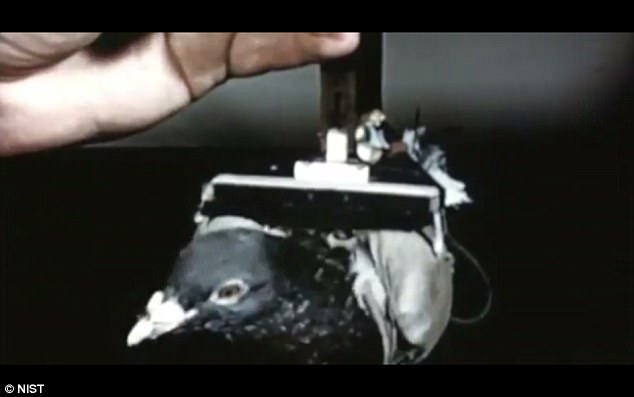
The pigeon would have a gold electrode attached to the end of its beck and peck at the image, which sent electrical signals to the servomechanism controlling the wings
This technology – nicknamed 'The Bat' – was used toward the end of the war in the Pacific.
This method, however, did have an obstacle that could've been prevented if Skinner's pigeon technique had been used instead – enemies could easily jam the radio signal.
But Skinner's research remains today and is used in devices used daily around the world.
These screens are constructed from materials like copper or indium tin oxide and store electrical charges in a grid of tiny wires.
When you touch them with a finger – which holds an electrical charge – you change the flow of electricity, allowing you to control the device.
There are different types of touch screen (such as the basic resistive ones used on ATMs), but conductive, or capacitive, ones are the industry standard for devices.
Using conductive spray paint, scientists have even found a way to make any object into a touch screen.
By spraying a thin coat that carries an electric charge onto a guitar, for example, it's possible to hook it up to a computer and make it respond to touch through a system called electric field tomography.
